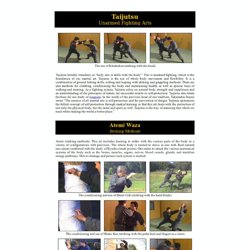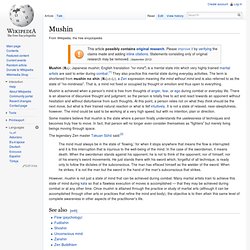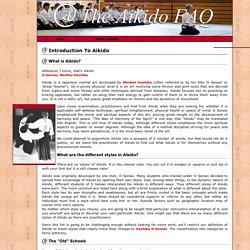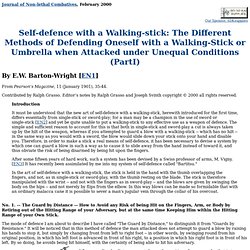

Samurai Sword Legend Musashi - Master of the Way of Martial Arts and Strategy. JNC, Barton-Wright, Self Defence with a cane part 2. Homepage. Taijutsu literally translates as “body arts or skills with the body”.

This is unarmed fighting, which is the foundation of our martial art. Taijutsu is the use of whole body movement and flexibility. It is a combination of ground hitting skills, rolling and leaping with striking and grappling methods. There are also methods for climbing, conditioning the body and maintaining health, as well as special ways of walking and running. As a fighting system, Taijutsu relies on natural body strength and suppleness and an understanding of the principles of nature, for successful results in self-protection. Shioda Gozo One of the great Aikido Legends. 養神館合気道、aikido Shioda Gozo demonstration part1 1978-1981. (6) Facebook. How to Get Bruce Lee Like Strength Without Ever Going to a Gym. Article by Zen Habits contributor Jonathan Mead; follow him on twitter. “Empty your mind, be formless, shapeless – like water. Now you put water into a cup, it becomes the cup, you put water into a bottle, it becomes the bottle, you put it in a teapot, it becomes the teapot.
Now water can flow or it can crash. Be water, my friend.” – Bruce Lee Bruce Lee was a paragon of cool and an icon of the ultimate bad-ass. What’s more impressive is that Bruce trained his body without ever stepping into a gym and with very little use of weights or machines. Here are just a few of Lee’s physical feats: Performed one-hand push-ups using only the thumb and index finger.Could hold an elevated v-sit position for 30 minutes or longer.Could throw grains of rice up into the air and then catch them in mid-flight using chopsticks.Could break wooden boards 6 inches (15 cm) thick.Performed 50 reps of one-arm chin-ups. You don’t have to buy lots of weights or machines, either.
Calisthenics. Fudōshin. Mushin. Mushin (無心; Japanese mushin; English translation "no mind") is a mental state into which very highly trained martial artists are said to enter during combat.[1] They also practice this mental state during everyday activities.

The term is shortened from mushin no shin (無心の心), a Zen expression meaning the mind without mind and is also referred to as the state of "no-mindness". That is, a mind not fixed or occupied by thought or emotion and thus open to everything. Some masters believe that mushin is the state where a person finally understands the uselessness of techniques and becomes truly free to move. In fact, that person will no longer even consider themselves as "fighters" but merely living beings moving through space.
The legendary Zen master Takuan Sōhō said:[2] The mind must always be in the state of 'flowing,' for when it stops anywhere that means the flow is interrupted and it is this interruption that is injurious to the well-being of the mind. See also[edit] References[edit] 36 Useful Sparring Tips. The Aikido FAQ: Introduction To Aikido. What is Aikido?

Whenever I move, that's Aikido. O Sensei, Morihei Ueshiba Aikido is a Japanese martial art developed by Morihei Ueshiba (often referred to by his title 'O Sensei' or 'Great Teacher'). On a purely physical level it is an art involving some throws and joint locks that are derived from Jujitsu and some throws and other techniques derived from Kenjutsu.
Aikido focuses not on punching or kicking opponents, but rather on using their own energy to gain control of them or to throw them away from you. Upon closer examination, practitioners will find from Aikido what they are looking for, whether it is applicable self-defense technique, spiritual enlightenment, physical health or peace of mind. We could attempt to pigeonhole Aikido into a synopsis of X number of words, but that would not do it justice, so we leave the practitioner of Aikido to find out what Aikido is for themselves without any preconceived notions. What are the different styles in Aikido? The "Old" Schools. Brazilian Jiu Jitsu Submissions. Excellent Aikido Demonstration. JNC, Barton-Wright, Self Defence with a cane part 1. Journal of Non-lethal Combatives, February 2000 From Pearson’s Magazine, 11 (January 1901), 35-44.

Contributed by Ralph Grasso. Editor’s notes by Ralph Grasso and Joseph Svinth copyright © 2000 all rights reserved. Introduction It must be understood that the new art of self-defence with a walking-stick, herewith introduced for the first time, differs essentially from single-stick or sword-play; for a man may be a champion in the use of sword or single-stick [EN2] and yet be quite unable to put a walking-stick to any effective use as a weapon of defence. The simple and sufficient reason to account for this is that both in single-stick and sword-play a cut is always taken up by the hilt of the weapon, whereas if you attempted to guard a blow with a walking-stick -- which has no hilt -- in the same way as you would with a sword, the blow would slide down your stick onto your hand and disable you.
No. 2. -- Another Way to Avoid being Hit by Retiring out of Range of your Adversary's Stick.